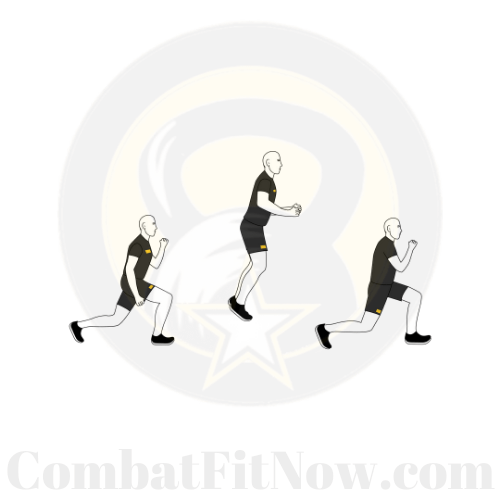Lunge jumps are a dynamic lower body exercise that combines the benefits of lunges with explosive movements. Here’s a step-by-step guide on how to perform lunge jumps correctly:
Video Instructions on How to do a Lunge Jump
Muscles worked:
- Quadriceps
- Hamstrings
- Glutes
- Calves
Instructions:
- Starting Position:
- Stand with your feet hip-width apart and your hands on your hips or at your sides.
- Engage your core muscles to stabilize your spine.
- Lunge Position:
- Take a step forward with your right foot, ensuring your knee is directly above your ankle, and your left knee is hovering just above the ground.
- Both knees should be bent at a 90-degree angle, with your back knee nearly touching the floor.
- Your back should be straight, and your chest should be upright.
- Preparation:
- Lower your body into a lunge position, keeping your weight evenly distributed between your front and back legs.
- Ensure that your front knee is aligned with your toes and does not extend past them to protect your knee joint.
- Jumping Phase:
- Explosively push off with both feet, propelling your body upward.
- As you jump, switch the position of your legs in mid-air, bringing your left foot forward and your right foot to the rear.
- Swing your arms to help generate upward momentum.
- Landing:
- Land softly on the ball of your left foot, bending both knees into a lunge position.
- Ensure that your knees are still aligned with your toes upon landing.
- Repeat:
- Immediately explode back up into the jump, switching your legs once again.
- Keep the movement controlled and maintain proper form throughout.
- Sets and Repetitions:
- Start with a few repetitions to get the form right before attempting a full set.
- Beginners may start with 2-3 sets of 10-12 repetitions.
- As you become more proficient, you can increase the intensity and volume.
Tips:
- Focus on a controlled and smooth movement to avoid unnecessary stress on your joints.
- Land softly to minimize impact and reduce the risk of injury.
- Keep your core engaged throughout the exercise to maintain stability.
- If you have any knee or joint issues, consult with a fitness professional or healthcare provider before attempting lunge jumps.
Remember to warm up before starting any exercise routine, and if you experience pain or discomfort, stop the exercise and consult a fitness professional or healthcare provider.



